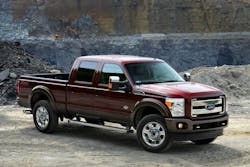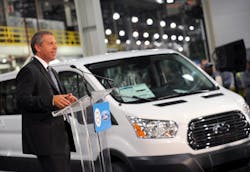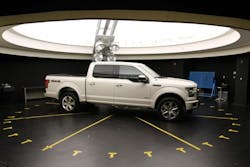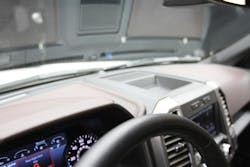Let’s start with the F-150’s “bigger brothers,” Ford’s F-Series Super Duty.
As it stands right now, the OEM expects to build its five millionth Super Duty unit – a line encompassing the F-250 up thru the F-550 – after 15 years of production at its Kentucky Truck Plant next month.
[On another front, the OEM also plans to overhaul its F-650 and F-750 medium-duty lineup for the 2016 model year, too: you can read more on that by clicking here.]
It’s also interesting to note the beefier capability of those Super Duty trucks since their introduction in 1999.
Back then, for example, Ford said the largest gasoline engine in the original Super Duty – the Triton 6.8-liter V10 – produced 275 hp and 410 lbs.-ft. of torque, while its 7.3-liter diesel engine produced 235 hp and 500 lbs.-ft. of torque.
Today, by contrast, the Super Duty 6.2-liter gasoline-fired V8 option delivers 385 hp and 405 lbs.-ft. of torque, while the 6.7-liter Power Stroke V8 turbo diesel supplies 440 hp and 860 lbs.-ft. of torque – all while offering better fuel economy compared to those 1999 powertrains.
That increase in engine power translates into more towing and payload, of course.
Back in 1999, for example, F-350 Super Duty pickup featured a maximum tow capacity rating of 14,600 lbs. But today, the 2015 model F-450 Super Duty pickup leads the way with a standard tow rating of 31,200 lbs.Some of the more interesting improvements of late, though, are happening over the commercial van side at Ford.
Take, for instance, the OEM’s 2015 Ford Transit Prisoner Transport Vehicle concept, or Transit PTV, which features what’s known as a “prisoner conveyance system” the OEM designed in partnership with Warminster, PA-based Havis Prisoner Transport Solutions.
The Transit PTV not only can carry 12 prisoners, it can do so with a much more fuel efficient footprint, thanks to its three engine options: a gasoline-fired 3.7-liter V6, a gasoline-powered 3.5-liter EcoBoost variant, and a 3.2-liter Power Stroke diesel engine.
Ford added that its new Transit van is garnering a lot of interest – to the point where the OEM just recently announced plans to add another 1,200 new jobs and a second shift to its Kansas City Assembly Plant, where the Transit is built.Joe Hinrichs (seen at right), Ford’s president for the Americas, stressed in an event last week that those 1,200 jobs are in addition to the 2,800 jobs added at Kansas City Assembly Plant in 2012 and 2013 to support the 2015 Transit launch and increased production of F-150 Regular Cab, SuperCab and SuperCrew pickups.
He noted that “KCAP,” as the plant is known, is projected to employ more than 6,000 hourly workers by the end of 2014, on a two-shift pattern for Transit production and three-crew pattern for F-150.
Speaking of the new 2015 model F-150, there are a few interesting tweaks to note before we start getting into its road-handling and payload-hauling particulars this week.
First, the new pickup features a veritable host of what Ford calls “driver-assist” technologies that consumers and commercial fleets alike should find extremely useful (you can read more about those by clicking here).
Yet perhaps one of the lesser-known upgrades to the 2015 version of the F-150 is how its exterior paint can better resist fading due to the sun’s rays.The OEM used a device known as a Thermatron at its Florida-based Central Lab to simulate damaging ultra violet (UV) sunrays on prototype parts to help identify the best design for production.
Antiglare testing took place in the Visual Performance Evaluation Lab, also known as the Ford lighting lab; a facility that can replicate almost any sunlight conditions from dawn to dusk using 6,000 watts of light within a planetarium-like dome. The facility can also create changes to natural light caused by weather conditions, noted Cindy McComb, one of the OEM’s materials engineers.
Even the Blue Oval and F-150 badges endured 3,000 hours of sun-like punishment in the OEM’s labs, McComb said – the equivalent of five years of exposure to actual sun rays. The company’s engineers also exposed the three-piece badge to temperatures as cold as 40 degrees below Celsius followed by blasts of 100-degree Celsius steam to help ensure chrome plating adheres so individual pieces of the badge won’t warp or crack.
On top of that, Ford’s Central Lab engineers placed individual exterior and interior parts on outside racks for six months at a time to look for fading and other signs of degradation. The parts were then examined under a special xenon light to reveal damage invisible to the human eye. Parts are approved for production only when they meet rigorous fade-resistance standards.“Direct sunlight does more than fade vehicle parts over time – it can also make it hard to see information displayed on gauges and screens used for navigation and entertainment systems,” McComb said. “So we used advanced computer-aided design software to identify the least reflective materials to use, and incorporated shaded gauges on the instrument panel of the all-new truck designed to minimize glare.”
In some cases, gauges and instruments shaded from glare are enhanced with supplemental lighting throughout the Ford F-150 interior to make them readable in their recessed positions, she added.
“By reducing indirect glare, the driver should practically never see a sun spot in the center screen or instrument cluster,” said Cary Diehl, a human factors engineer at Ford. “In addition to testing gauges and screens under these conditions, we looked at the amount of light given off by LEDs [light emitting diodes] in window and steering wheel control switches to ensure they would not be distracting to the driver when lit.”
Why? Because F-150 customers using their trucks at job sites don’t have the time or the patience to deal with hard-to-read gauges or controls inside the truck.
“Our work in the lighting lab ensures that despite almost any weather outside, customers will find it easy to read controls inside the truck today and years down the road,” noted Mahendra Dassanayake, one of Ford’s lighting technical specialists.
Certainly sheds new “light” on the subject of light truck testing, now doesn’t it? One can only wonder, then, what other design “tweaks” await examination of the 2015 model F-150 in the Lone Star State this week.








